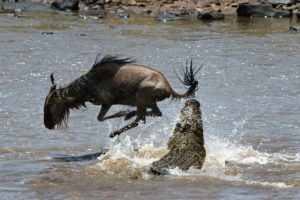The Great Wildebeest Migration is one of the most spectacular natural events in the world. It involves the mass movement of over 1.5 million wildebeest, along with hundreds of thousands of zebras and gazelles, as they travel across the Serengeti-Mara ecosystem in search of fresh grazing and water.
The migration is a continuous, year-round journey that follows a clockwise route through the Serengeti in Tanzania and the Maasai Mara in Kenya and is influenced by the seasonal rains, which dictate the growth of grass across the plains. The Great Migration attracts thousands of tourists annually, providing significant revenue for local communities and conservation efforts to Both Kenya and Tanzania.
Safaris and guided tours are popular, with options ranging from luxury lodges to mobile camping experiences.
Cycle of the Migration
There a serious of incidents which determines this great move, they include
- Calving Season (January to March): This occurs in the southern Serengeti, where the wildebeest give birth to around 500,000 calves over a short period. This season attracts many predators like lions, leopards, hyenas, Cheetahs due to the abundance of vulnerable young.
- Northward Movement: (April to June): The herds start moving northwards towards the central Serengeti. Towards the Grumeti River, where the wildebeest must navigate crocodile-infested waters.
- Mara River Crossings (July to September): This is the most dramatic phase, as the herds cross the Mara River into Kenya’s Maasai Mara, facing strong currents and predators.
- Northern Plains and Return (October to December): After grazing in the Maasai Mara, the herds gradually move back south to the Serengeti to start the cycle again.

Best Viewing Time:
The prime time to witness the migration in the Maasai Mara is from late July to early October when the herds are usually in the area. The Mara River crossings are a particular highlight, offering intense scenes of predator-prey interactions.
Conservation Importance:
The migration is crucial for maintaining the ecological balance of the region. It supports a diverse array of wildlife and helps sustain the grasslands.
Both the Serengeti and Maasai Mara are protected areas, with efforts continually made to ensure the conservation of this natural phenomenon.
Witnessing the Great Wildebeest Migration is a bucket-list experience for many nature enthusiasts and photographers, offering unparalleled opportunities to observe one of nature’s most extraordinary spectacles.
The Great Beast Migration, more commonly known as the Great Wildebeest Migration, is one of the most impressive and well-documented wildlife spectacles on Earth. It involves the annual movement of over 1.5 million wildebeest, along with hundreds of thousands of zebras and antelopes, across the Serengeti-Mara ecosystem in East Africa. This migration is driven by the search for fresh grazing and water and is influenced by the seasonal rains.
